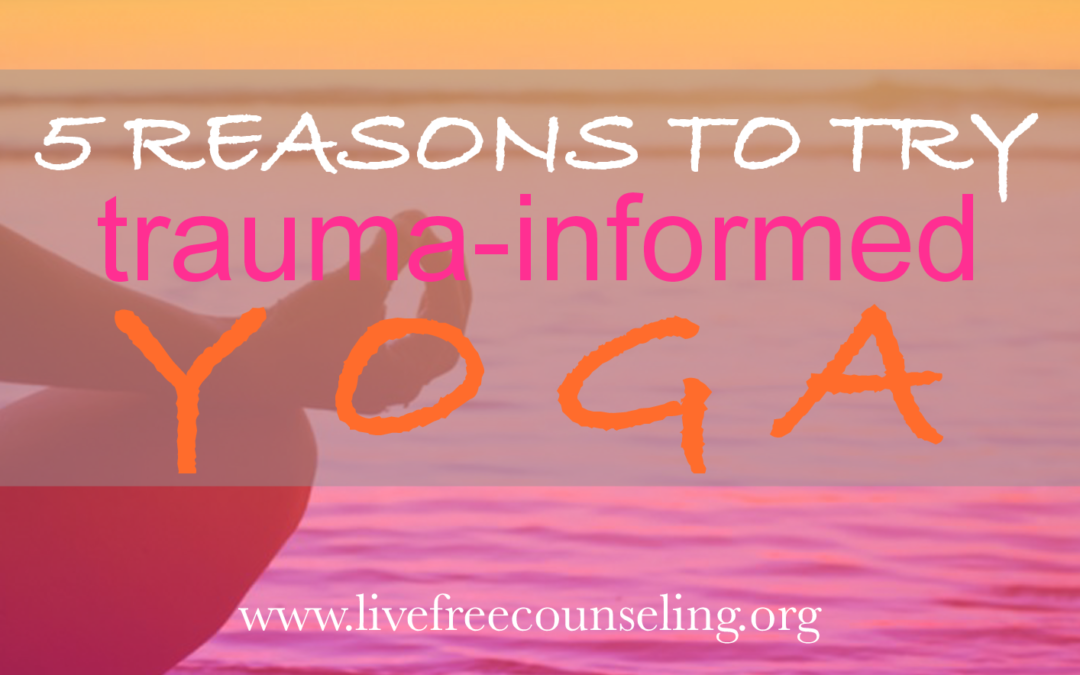Heal the Mind Through the Body:
5 Reasons to Try Trauma-Informed Yoga
In recent years, a growing body of evidence has shown yoga to be an effective adjunctive treatment for people suffering from mental health disorders such as anxiety and depression. If you’re a trauma survivor, or if you’re experiencing symptoms that disrupt your life, here are 5 reasons why you should try trauma-informed yoga.
1. No prior yoga experience necessary.
Some people are intimidated to try yoga because they don’t know the jargon, and they’re confused about the spiritual aspects. In trauma-informed yoga, there are no complicated foreign words or phrases to memorize, nor is there any association with a particular spiritual practice or religion. In fact, some instructors feel calling it “yoga” can be misleading. Instead, it may be better thought of as “mindful movements” with an emphasis on noticing the present experience in the body.
2. All fitness levels and body types are welcome
Another reason many people avoid yoga is they don’t think they are flexible or fit enough. Trauma-informed yoga is not a fitness class. It is a mind-body practice that emphasizes slow and gentle movements that allow participants to connect to the feelings and sensations in their bodies in the moment. As the weeks go by, more forms and movements are introduced that may increase the heart rate or fatigue the muscles, but the focus remains on noticing the physical experiences happening in the body.
3. The environment is safe and non-judgmental
Safety and a non-judgemental environment is paramount to the trauma-informed yoga experience. Fostering that safety includes avoiding any language that may be triggering and making sure the exits are clearly visible and accessible to students. Mats are set up in such a way that no one is immediately behind or in front of another person, and there are no mirrors in the room. If music is played, it is neutral and instrumental. The instructor remains on their own mat in the front of the room, and absolutely no hands-on physical adjustments are given.
4. Participants are empowered to make choices and listen to their bodies
Unlike traditional yoga, in which the instructor tells the students what to do, trauma-informed yoga is non-directive and is focused on allowing each participant to make choices throughout the practice that best serve them. Each movement introduced by the instructor will include at least two options for a student to choose from. Also, a third option always available is to do nothing or to do whatever feels right to that person. In this way, each participant is encouraged to tune into their own body and experience and decide for themselves what feels helpful or accessible. There is no requirement to follow the instructor, and there is no judgement when students choose their own movement.
5. Benefits are backed by research and evidence
Trauma-informed yoga is considered an empirically validated and effective treatment for improving coping skills and reducing symptoms associated with trauma and stress disorders. Some additional benefits include improved mastery and control over one’s own body, an increased ability to tolerate strong emotions, a restored sense of safety and self-worth, inclusion in a supportive community of survivors, and a greater overall sense of peace and well-being.
At LiveFree Counseling we now offer trauma-informed yoga at our location in Castle Rock. This March, we’ll be starting new Trauma-Informed Yoga Classes. It will be an 8-session, closed group program. Click here for more details or to register, please call 720.465.6180 ext. 705, or email therapist Courtneyrose Chung at courtneyrose@livefreecounseling.org.

